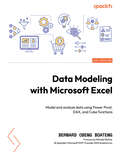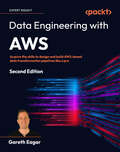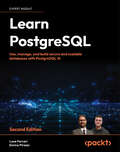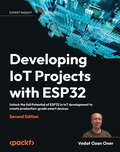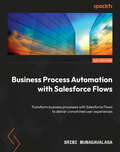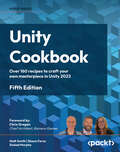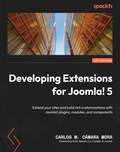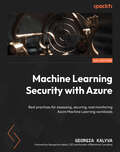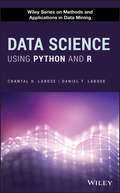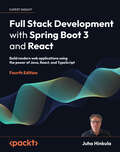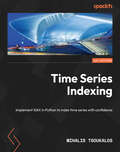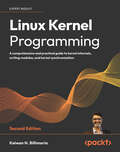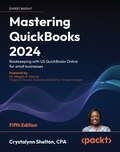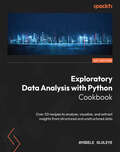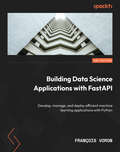- Table View
- List View
Masculinity, Marriage and Rural Men in Urban China: Modest Expectations (Routledge/Asian Studies Association of Australia (ASAA) East Asian Series)
by Sarah GosperThis book explores the conjuncture and interrelationship between three so-called ‘crises’ facing Chinese society: a crisis of marriage, a crisis of masculinity and a crisis of mobility.Based on sustained ethnographic research on unmarried lower-class rural men from two distinct social and class categories, namely migrant workers employed in the food delivery and express mail delivery industries and tertiary educated, white collar professionals, the book reveals how the increasing socio-economic precarity of rural men and their largely unrealised desires to marry and have children demonstrates a fundamental reconfiguration of Chinese masculinity and mobility in urban China and the social impact on central Chinese institutions. The book also reveals the futile efforts to fulfil hegemonic models of masculinity in contemporary China and addresses the heterogeneity of unmarried lower-class rural men as they navigate marriage, manhood and mobility.Exploring gender relations in China and contributing to global studies of heterosexual masculinities, this book will appeal to students and scholars of Chinese culture and society, gender studies and social anthropology.
Developing Kaggle Notebooks: Pave your way to becoming a Kaggle Notebooks Grandmaster
by Gabriel PredaPrinted in Color Develop an array of effective strategies and blueprints to approach any new data analysis on the Kaggle platform and create Notebooks with substance, style and impact Leverage the power of Generative AI with Kaggle Models Purchase of the print or Kindle book includes a free PDF eBookKey FeaturesMaster the basics of data ingestion, cleaning, exploration, and prepare to build baseline modelsWork robustly with any type, modality, and size of data, be it tabular, text, image, video, or soundImprove the style and readability of your Notebooks, making them more impactful and compellingBook DescriptionDeveloping Kaggle Notebooks introduces you to data analysis, with a focus on using Kaggle Notebooks to simultaneously achieve mastery in this fi eld and rise to the top of the Kaggle Notebooks tier. The book is structured as a sevenstep data analysis journey, exploring the features available in Kaggle Notebooks alongside various data analysis techniques. For each topic, we provide one or more notebooks, developing reusable analysis components through Kaggle's Utility Scripts feature, introduced progressively, initially as part of a notebook, and later extracted for use across future notebooks to enhance code reusability on Kaggle. It aims to make the notebooks' code more structured, easy to maintain, and readable. Although the focus of this book is on data analytics, some examples will guide you in preparing a complete machine learning pipeline using Kaggle Notebooks. Starting from initial data ingestion and data quality assessment, you'll move on to preliminary data analysis, advanced data exploration, feature qualifi cation to build a model baseline, and feature engineering. You'll also delve into hyperparameter tuning to iteratively refi ne your model and prepare for submission in Kaggle competitions. Additionally, the book touches on developing notebooks that leverage the power of generative AI using Kaggle Models.What you will learnApproach a dataset or competition to perform data analysis via a notebookLearn data ingestion and address issues arising with the ingested dataStructure your code using reusable componentsAnalyze in depth both small and large datasets of various typesDistinguish yourself from the crowd with the content of your analysisEnhance your notebook style with a color scheme and other visual effectsCaptivate your audience with data and compelling storytelling techniquesWho this book is forThis book is suitable for a wide audience with a keen interest in data science and machine learning, looking to use Kaggle Notebooks to improve their skills and rise in the Kaggle Notebooks ranks. This book caters to: Beginners on Kaggle from any background Seasoned contributors who want to build various skills like ingestion, preparation, exploration, and visualization Expert contributors who want to learn from the Grandmasters to rise into the upper Kaggle rankings Professionals who already use Kaggle for learning and competing
Et al: Because not all research deserves a Nobel Prize
by B McGrawEt al. is a satirical academic journal that uses machine learning and scientific principles on absurd studies, from the cat Lord Whiskers' role in the extinction of the dodo bird to the quantum mysteries of untidy toddler rooms.Key FeaturesConducts satirical research on topics ranging from quantum computing to clingy robot dog algorithmsAnswers questions like “Can a computer understand a Scotsman?” and “Is Sarah Palin real?”Secures the power grid and your home from the prying eyes of government drones a.k.a. birdsExpands science by studying cow-based atmospheres, and the flavortown center of the brainSolves climate change and saves the world by proposing a banana-based fission reactorNullifies the possibility of getting lost at the fair with a mirror-house escape algorithmBook DescriptionTired of the same old math, science, statistics, and programming memes people post online and want something a little more elaborate? This is the book for you. Tremble as we make up all our own facts and data, hand-draw diagrams in MS Paint, and quote from fictional studies and journals. Cower as authors write in the first person because their study is just a little too personal for them. Recoil from the sheer mass of oversimplified methodology, distilling someone's entire thesis into a paragraph of jokes crude enough to make it into a Mike Myers movie. Over the last few years, we have taken arguments that you would normally have after four Jack and cokes at game night and turned them into properly formatted research papers with a writing tone serious enough to confuse the uninitiated. These papers are high-effort jokes by researchers and scientists for researchers and scientists. They cover a range of topics such as the consequences of re-releasing tourists back into Yellowstone National Park after COVID-19, how to play StarCraft competitively online on a quantum computer, and most importantly, how trees around the globe are becoming increasingly radicalized.What you will learnHow to draw a graph using MS Paint, maybeWhether Sarah Palin is a figment of your imaginationHow one pirate cat brought about the extinction of the beloved dodoWhy rabbits used to be jerks back in the dayIf you actually learn anything from these articles, get your memory erased immediatelyWho this book is forThis book is for researchers and those who love science mingled with humor. It's for those who are a little too tired of the talking heads and futurists of the science world and would like something more entertaining in the form of absurd speculative studies by researchers as unbelievable as their work. Anyone who has experienced academic writing, or the tribulations of any research institution will enjoy the wide range of bizarre, yet real-world topics compiled in this book. Even if you don't know much about the subject, we usually have a background section.
Data Modeling with Microsoft Excel: Model and analyze data using Power Pivot, DAX, and Cube functions
by Bernard Obeng BoatengSave time analyzing volumes of data using a structured method to extract, model, and create insights from your dataKey FeaturesAcquire expertise in using Excel’s Data Model and Power Pivot to connect and analyze multiple sources of dataCreate key performance indicators for decision making using DAX and Cube functionsApply your knowledge of Data Model to build an interactive dashboard that delivers key insights to your usersPurchase of the print or Kindle book includes a free PDF eBookBook DescriptionMicrosoft Excel's BI solutions have evolved, offering users more flexibility and control over analyzing data directly in Excel. Features like PivotTables, Data Model, Power Query, and Power Pivot empower Excel users to efficiently get, transform, model, aggregate, and visualize data. Data Modeling with Microsoft Excel offers a practical way to demystify the use and application of these tools using real-world examples and simple illustrations. This book will introduce you to the world of data modeling in Excel, as well as definitions and best practices in data structuring for both normalized and denormalized data. The next set of chapters will take you through the useful features of Data Model and Power Pivot, helping you get to grips with the types of schemas (snowflake and star) and create relationships within multiple tables. You’ll also understand how to create powerful and flexible measures using DAX and Cube functions. By the end of this book, you’ll be able to apply the acquired knowledge in real-world scenarios and build an interactive dashboard that will help you make important decisions. Note: To access the supplemental material, subscribers should purchase a print copy of the book. The ebook can be accessed through the QR code or link provided inside the Print book. Proof of purchase is mandatory to access the ebook.What you will learnImplement the concept of data modeling within and beyond ExcelGet, transform, model, aggregate, and visualize data with Power QueryUnderstand best practices for data structuring in MS ExcelBuild powerful measures using DAX from the Data ModelGenerate flexible calculations using Cube functionsDesign engaging dashboards for your usersWho this book is forThis book is for Excel users looking for hands-on and effective methods to manage and analyze large volumes of data within Microsoft Excel using Power Pivot. Whether you’re new or already familiar with Excel’s data analytics tools, this book will give you further insights on how you can apply Power Pivot, Data Model, DAX measures, and Cube functions to save time on routine data management tasks. An understanding of Excel’s features like tables, PivotTable, and some basic aggregating functions will be helpful but not necessary to make the most of this book.
Data Engineering with AWS: Acquire the skills to design and build AWS-based data transformation pipelines like a pro
by Gareth EagarLooking to revolutionize your data transformation game with AWS? Look no further! From strong foundations to hands-on building of data engineering pipelines, our expert-led manual has got you covered.Key FeaturesDelve into robust AWS tools for ingesting, transforming, and consuming data, and for orchestrating pipelinesStay up to date with a comprehensive revised chapter on Data GovernanceBuild modern data platforms with a new section covering transactional data lakes and data meshBook DescriptionThis book, authored by a seasoned Senior Data Architect with 25 years of experience, aims to help you achieve proficiency in using the AWS ecosystem for data engineering. This revised edition provides updates in every chapter to cover the latest AWS services and features, takes a refreshed look at data governance, and includes a brand-new section on building modern data platforms which covers; implementing a data mesh approach, open-table formats (such as Apache Iceberg), and using DataOps for automation and observability. You'll begin by reviewing the key concepts and essential AWS tools in a data engineer's toolkit and getting acquainted with modern data management approaches. You'll then architect a data pipeline, review raw data sources, transform the data, and learn how that transformed data is used by various data consumers. You’ll learn how to ensure strong data governance, and about populating data marts and data warehouses along with how a data lakehouse fits into the picture. After that, you'll be introduced to AWS tools for analyzing data, including those for ad-hoc SQL queries and creating visualizations. Then, you'll explore how the power of machine learning and artificial intelligence can be used to draw new insights from data. In the final chapters, you'll discover transactional data lakes, data meshes, and how to build a cutting-edge data platform on AWS. By the end of this AWS book, you'll be able to execute data engineering tasks and implement a data pipeline on AWS like a pro!What you will learnSeamlessly ingest streaming data with Amazon Kinesis Data FirehoseOptimize, denormalize, and join datasets with AWS Glue StudioUse Amazon S3 events to trigger a Lambda process to transform a fileLoad data into a Redshift data warehouse and run queries with easeVisualize and explore data using Amazon QuickSightExtract sentiment data from a dataset using Amazon ComprehendBuild transactional data lakes using Apache Iceberg with Amazon AthenaLearn how a data mesh approach can be implemented on AWSWho this book is forThis book is for data engineers, data analysts, and data architects who are new to AWS and looking to extend their skills to the AWS cloud. Anyone new to data engineering who wants to learn about the foundational concepts, while gaining practical experience with common data engineering services on AWS, will also find this book useful. A basic understanding of big data-related topics and Python coding will help you get the most out of this book, but it’s not a prerequisite. Familiarity with the AWS console and core services will also help you follow along.
Practical Guide to Applied Conformal Prediction in Python: Learn and apply the best uncertainty frameworks to your industry applications
by Valery ManokhinElevate your machine learning skills using the Conformal Prediction framework for uncertainty quantification. Dive into unique strategies, overcome real-world challenges, and become confident and precise with forecasting.Key FeaturesMaster Conformal Prediction, a fast-growing ML framework, with Python applicationsExplore cutting-edge methods to measure and manage uncertainty in industry applicationsUnderstand how Conformal Prediction differs from traditional machine learningBook DescriptionIn the rapidly evolving landscape of machine learning, the ability to accurately quantify uncertainty is pivotal. The book addresses this need by offering an in-depth exploration of Conformal Prediction, a cutting-edge framework to manage uncertainty in various ML applications. Learn how Conformal Prediction excels in calibrating classification models, produces well-calibrated prediction intervals for regression, and resolves challenges in time series forecasting and imbalanced data. Discover specialised applications of conformal prediction in cutting-edge domains like computer vision and NLP. Each chapter delves into specific aspects, offering hands-on insights and best practices for enhancing prediction reliability. The book concludes with a focus on multi-class classification nuances, providing expert-level proficiency to seamlessly integrate Conformal Prediction into diverse industries. With practical examples in Python using real-world datasets, expert insights, and open-source library applications, you will gain a solid understanding of this modern framework for uncertainty quantification. By the end of this book, you will be able to master Conformal Prediction in Python with a blend of theory and practical application, enabling you to confidently apply this powerful framework to quantify uncertainty in diverse fields.What you will learnThe fundamental concepts and principles of conformal predictionLearn how conformal prediction differs from traditional ML methodsApply real-world examples to your own industry applicationsExplore advanced topics - imbalanced data and multi-class CPDive into the details of the conformal prediction frameworkBoost your career as a data scientist, ML engineer, or researcherLearn to apply conformal prediction to forecasting and NLPWho this book is forIdeal for readers with a basic understanding of machine learning concepts and Python programming, this book caters to data scientists, ML engineers, academics, and anyone keen on advancing their skills in uncertainty quantification in ML.
Learn PostgreSQL: Use, manage, and build secure and scalable databases with PostgreSQL 16
by Luca Ferrari Enrico PirozziThis new edition will help you learn PostgreSQL from scratch with the latest version, providing a complete focused view on aspects like configuration, high performance, partitioning, backup, server-side programming and replication. Purchase of the print or Kindle book includes a free eBook in PDF format.Key FeaturesLearn the fundamentals of PostgreSQL 16, including SQL statements, replication, and securityEnhance your learning journey with the provided Docker images for practical hands-on exercises and tests at the end of each chapterGet new and improved examples, use-cases, and scenarios specifically for concepts like partitioning, replication, back-up and restore, cluster configuration, monitoring and othersBook DescriptionThe latest edition of this PostgreSQL book will help you to start using PostgreSQL from absolute scratch, helping you to quickly understand the internal workings of the database. With a structured approach and practical examples, go on a journey that covers the basics, from SQL statements and how to run server-side programs, to configuring, managing, securing, and optimizing database performance. This new edition will not only help you get to grips with all the recent changes within the PostgreSQL ecosystem but will also dig deeper into concepts like partitioning and replication with a fresh set of examples. The book is also equipped with Docker images for each chapter which makes the learning experience faster and easier. Starting with the absolute basics of databases, the book sails through to advanced concepts like window functions, logging, auditing, extending the database, configuration, partitioning, and replication. It will also help you seamlessly migrate your existing database system to PostgreSQL and contains a dedicated chapter on disaster recovery. Each chapter ends with practice questions to test your learning at regular intervals. By the end of this book, you will be able to install, configure, manage, and develop applications against a PostgreSQL database.What you will learnGain a deeper understanding of PostgreSQL internals like transactions, MVCC, security and replicationEnhance data management with PostgreSQL's latest partitioning featuresChoose the right replication strategy for your databaseSee concrete examples of how to migrate data from another database, perform backups and restores, monitor your PostgreSQL installation and moreEnsure security and compliance with schemas and user privilegesCreate customized database functions and extensionsGet to grips with server-side programming, window functions, and triggersWho this book is forLearning PostgresSQL 16 book is for anyone interested in learning about the PostgreSQL database from scratch. Anyone looking to build robust data warehousing applications and scale the database for high-availability and performance using the latest features of PostgreSQL will also find this book useful. Although prior knowledge of PostgreSQL is not required, familiarity with databases is expected.
RPA Solution Architect's Handbook: Design modern and custom RPA solutions for digital innovation
by Sachin SahgalDrive digital transformation by increasing efficiency and ROI for your organization as a robotic process automation (RPA) solution architect Purchase of the print or Kindle book includes a free PDF eBookKey FeaturesLearn architectural design and analysis of enterprise-wide RPA systems with real-world use casesExplore tips and best practices to deliver scalable business outcomes through RPA implementationOvercome challenges in intelligent automation, data, and security while building RPA solutionsBook DescriptionRPA solution architects play an important role in the automation journey and initiatives within the organization. However, the implementation process is quite complex and daunting at times. RPA Solution Architect’s Handbook is a playbook for solution architects looking to build well-designed and scalable RPA solutions. You’ll begin by understanding the different roles, responsibilities, and interactions between cross-functional teams. Then, you’ll learn about the pillars of a good design: stability, maintainability, scalability, and resilience, helping you develop a process design document, solution design document, SIT/UAT scripts, and wireframes. You’ll also learn how to design reusable components for faster, cheaper, and better RPA implementation, and design and develop best practices for module decoupling, handling garbage collection, and exception handling. At the end of the book, you’ll explore the concepts of privacy, security, reporting automated processes, analytics, and taking preventive action to keep the bots healthy. By the end of this book, you’ll be well equipped to undertake a complete RPA process from design to implementation efficiently.What you will learnUnderstand the architectural considerations for stability, maintainability, and resilience for effective RPA solution designInteract with cross-functional teams for seamless RPA implementationWrite effective RPA documentation, non-functional requirements, and effective UAT scriptsDemo RPA solutions, receive feedback, and triage additional requirements based on complexity, time, and costDesign considerations for intelligent automation and learn about RPA as a serviceExplore best practices for decoupling, handling garbage collection, and exception handlingWho this book is forThis book is for RPA developers, RPA Sr. developers, or RPA analysts looking to become RPA solution architects. If you are an RPA solution architect, then this book can help you advance your understanding and become more efficient. Familiarity with RPA documentation like SDD, and PDD along with hands-on experience with either one or more RPA tools will be helpful but is not mandatory.
Mastering Kubernetes: Dive into Kubernetes and learn how to create and operate world-class cloud-native systems
by Gigi SayfanGo beyond the basics of Kubernetes and explore more advanced concepts, including Kubernetes in production, governance, serverless computing, and service meshes. Purchase of the print or Kindle book includes a free eBook in PDF format.Key FeaturesMaster Kubernetes architecture and design to build, deploy, and secure large-scale distributed systemsLearn advanced concepts like autoscaling, multi-cluster management, serverless computing, service meshes and policy enginesExplore Kubernetes 1.25 and its rich ecosystem of tools like Kubectl, Krew, K9s, Lens, and HelmBook DescriptionThe fourth edition of the bestseller Mastering Kubernetes includes the most recent tools and code to enable you to learn the latest features of Kubernetes 1.25. This book contains a thorough exploration of complex concepts and best practices to help you master the skills of designing and deploying large-scale distributed systems on Kubernetes clusters. You’ll learn how to run complex stateless and stateful microservices on Kubernetes, including advanced features such as horizontal pod autoscaling, rolling updates, resource quotas, and persistent storage backends. In addition, you’ll understand how to utilize serverless computing and service meshes. Further, two new chapters have been added. “Governing Kubernetes” covers the problem of policy management, how admission control addresses it, and how policy engines provide a powerful governance solution. “Running Kubernetes in Production” shows you what it takes to run Kubernetes at scale across multiple cloud providers, multiple geographical regions, and multiple clusters, and it also explains how to handle topics such as upgrades, capacity planning, dealing with cloud provider limits/quotas, and cost management. By the end of this Kubernetes book, you’ll have a strong understanding of, and hands-on experience with, a wide range of Kubernetes capabilities.What you will learnLearn how to govern Kubernetes using policy enginesLearn what it takes to run Kubernetes in production and at scaleBuild and run stateful applications and complex microservicesMaster Kubernetes networking with services, Ingress objects, load balancers, and service meshesAchieve high availability for your Kubernetes clustersImprove Kubernetes observability with tools such as Prometheus, Grafana, and JaegerExtend Kubernetes with the Kubernetes API, plugins, and webhooksWho this book is forIf you're a system administrator or cloud developer who wants to become comfortable with Kubernetes and would like to master its advanced features, then this book is for you. Software and DevOps engineers with a working knowledge of Kubernetes, as well as technical managers of Kubernetes-based systems, will also find this book useful. Those deciding on whether to migrate to Kubernetes and are curious about its inner workings will find plenty of answers here as well. Basic familiarity with networking concepts will prove beneficial.
Terraform Cookbook: Master Infrastructure as Code efficiency with real-world Azure automation using Terraform
by Mikael KriefExplore how to provision, manage, and scale your infrastructure using Infrastructure as Code (IaC) with Terraform Purchase of the print or Kindle book includes a free PDF eBookKey FeaturesGet up and running with Terraform (v1+) CLI and automate infrastructure provisioningDiscover how to deploy Kubernetes resources with TerraformBecome a Terraform troubleshooting expert for streamlined infrastructure management and minimal downtimeBook DescriptionImagine effortlessly provisioning complex cloud infrastructure across various cloud platforms, all while ensuring robustness, reusability, and security. Introducing the Terraform Cookbook, Second Edition - your go-to guide for mastering Infrastructure as Code (IaC) effortlessly. This new edition is packed with real-world examples for provisioning robust Cloud infrastructure mainly across Azure but also with a dedicated chapter for AWS and GCP. You will delve into manual and automated testing with Terraform configurations, creating and managing a balanced, efficient, reusable infrastructure with Terraform modules. You will learn how to automate the deployment of Terraform configurations through continuous integration and continuous delivery (CI/CD), unleashing Terraform's full potential. New chapters have been added that describe the use of Terraform for Docker and Kubernetes, and explain how to test Terraform configurations using different tools to check code and security compliance. The book devotes an entire chapter to achieving proficiency in Terraform Cloud, covering troubleshooting strategies for common issues and offering resolutions to frequently encountered errors. Get the insider knowledge to boost productivity with Terraform - the indispensable guide for anyone adopting Infrastructure as Code solutions.What you will learnUse Terraform to build and run cloud and Kubernetes infrastructure using IaC best practicesAdapt the Terraform command line adapted to appropriate use casesAutomate the deployment of Terraform confi guration with CI/CDDiscover manipulation of the Terraform state by adding or removing resourcesExplore Terraform for Docker and Kubernetes deployment, advanced topics on GitOps practices, and Cloud Development Kit (CDK)Add and apply test code and compliance security in Terraform configurationDebug and troubleshoot common Terraform errorsWho this book is forThis book is for developers, operators, and DevOps engineers looking to improve their workflow and use Infrastructure as Code. If you find yourself spending too much time on manual infrastructure provisioning, struggling to manage complex deployments across environments, or facing unexpected downtime due to infrastructure issues then this book is meant for you. Experience with Microsoft Azure, Jenkins, shell scripting, and DevOps practices is required to get the most out of this Terraform book.
Developing IoT Projects with ESP32: Unlock the full Potential of ESP32 in IoT development to create production-grade smart devices
by Vedat Ozan OnerFrom smart sensors to cloud integration and the world of TinyML, this book is your comprehensive guide to the IoT ecosystem, using the ESP32 and industry-standard tools and technologiesKey FeaturesBuild IoT projects from scratch using ESP32Customize solutions, take them to cloud, visualize real-time data, implement security featuresPractice using a variety of hands-on projects such as an audio player, smart home, and moreBook DescriptionESP32, a low-cost and energy-efficient system-on-a-chip microcontroller, has become the backbone of numerous WiFi devices, fueling IoT innovation. This book offers a holistic approach to building an IoT system from the ground up, ensuring secure data communication from sensors to cloud platforms, empowering you to create production-grade IoT solutions using the ESP32 SoC. Starting with IoT essentials supported by real-world use cases, this book takes you through the entire process of constructing an IoT device using ESP32. Each chapter introduces new dimensions to your IoT applications, covering sensor communication, the integration of prominent IoT libraries like LittleFS and LVGL, connectivity options via WiFi, security measures, cloud integration, and the visualization of real-time data using Grafana. Furthermore, a dedicated section explores AI/ML for embedded systems, guiding you through building and running ML applications with tinyML and ESP32-S3 to create state-of-the-art embedded products. This book adopts a hands-on approach, ensuring you can start building IoT solutions right from the beginning. Towards the end of the book, you'll tackle a full-scale Smart Home project, applying all the techniques you've learned in real-time. Embark on your journey to build secure, production-grade IoT systems with ESP32 today!What you will learnExplore ESP32 with IDE and debugging tools for effective IoT creationDrive GPIO, I2C, multimedia, and storage for seamless integration of external devicesUtilize handy IoT libraries to enhance your ESP32 projectsManage WiFi like a pro with STA & AP modes, provisioning, and ESP Rainmaker framework featuresEnsure robust IoT security with secure boot and OTA firmware updatesHarness AWS IoT for data handling and achieve stunning visualization using GrafanaEnhance your projects with voice capabilities using ESP AFE and Speech RecognitionInnovate with tinyML on ESP32-S3 and the Edge Impulse platformWho this book is forIf you are an embedded software developer, an IoT software architect or developer, a technologist, or anyone who wants to learn how to use ESP32 and its applications, this book is for you. A basic understanding of embedded systems, programming, networking, and cloud computing concepts is necessary to get started with the book.
Business Process Automation with Salesforce Flows: Transform business processes with Salesforce Flows to deliver unmatched user experiences
by Srini MunagavalasaCreate seamless and structured workflows that can streamline complicated business processes with this comprehensive BPA bookKey FeaturesExplore business processes for automation to add value for your business usersAnalyze, evaluate, and devise effective ways to implement automation through Salesforce FlowsBecome an expert in flow orchestration and compose complex business processes using real-world examples, tips, and tricksPurchase of the print or Kindle book includes a free PDF eBookBook DescriptionThe low adoption of most IT projects often stems from a lack of business process automation. While business users get the functionality they need, the excessive manual steps involved in execution impede efficiency. Business Process Automation with Salesforce Flows will address this issue by helping you recognize the need for automation and guiding you through automating such processes. This book starts by quickly exploring various aspects of process automation using Salesforce Flows, covering flow nuts and bolts, flow structure, flow execution order, and different types of flows, as well as troubleshooting techniques to manage your processes using the Flow Builder tool. You’ll then become acquainted with the Flow Orchestration tool, which enables you to compose and orchestrate complex business processes. Through real-world scenarios, you’ll learn how to effectively automate business processes, follow the end-to-end business process flow, automate it using flow orchestration, and learn how to demystify and simplify business process automation. By the end of this book, you’ll be proficient in seamlessly automating your business processes without any hassle.What you will learnGain insights into gathering business requirements and identifying automation needsIdentify opportunities for improving business process flowsTranslate critical steps in the business process flow and automate them using Flow BuilderIdentify different types of Salesforce Flows tailored to various scenariosOptimize and troubleshoot Salesforce Flows for increased efficiencyDiscover ways to implement complex business process automation through flow orchestrationWho this book is forThis book is for system administrators, technical team members, and business analysts with a solid understanding of the Salesforce CRM software who want to effectively automate business processes using Salesforce Flows. Administrative-level Salesforce experience, along with some technical experience working with automation tools like Workflow, Process Builder, and Flows, will facilitate a better comprehension of the concepts covered in this book.
Unity Cookbook: Over 160 recipes to craft your own masterpiece in Unity 2023
by Matt Smith Shaun Ferns Sinéad MurphyAre you ready to take your Unity game development skills to the next level? Look no further! The "Unity Cookbook 2023, 5th Edition" is your essential guide to mastering the latest features of Unity 2023, packed with over 140 recipes to empower your game development journey. Purchase of the print or Kindle book includes a free eBook in the PDF format.Key FeaturesExplore VR and AR development to create immersive experiences that redefine gamingCraft captivating mobile games with optimized performance and user-friendly controlsElevate gameplay with expertly composed music, dynamic sound effects, and seamless audio integrationBook DescriptionUnleash your game development potential with Unity Cookbook, 5th Edition, designed to equip you with the skills and knowledge needed to excel in Unity game development. With over 160 expertly crafted recipes empowering you to pioneer VR and AR experiences, excel in mobile game development, and become a master of audio techniques. In this latest edition, we've meticulously curated a collection of recipes that reflect the latest advancements in Unity 2023, ensuring you stay at the forefront of game development. You'll discover dedicated recipes for First/Third Person (Core) templates, create engaging mobile games, delve into Virtual and Augmented Reality, and go further with audio by exploring advanced techniques. Additionally, the book has been fully updated to incorporate the new input system and TextMeshPro, essential elements for modern game development. From exploring C# scripting to crafting stylish UIs, creating stunning visual effects, and understanding shader development through Shader Graph, every chapter is designed to take you closer to your goal of becoming a proficient Unity developer. So, whether you're aiming to develop the next hit game, enhance your portfolio, or simply have fun building games, this book will be your trusted companion on your journey to Unity proficiency.What you will learnCraft stylish user interfaces, from power bars to radars, and implement button-driven scene changes effortlesslyEnhance your games with AI controlled characters, harnessing Unity's navigation meshes, surfaces, and agentsDiscover the power of Cinemachine in Unity for intelligent camera movementsElevate games with immersive audio, including background music and dynamic sound effectsBring your games to life with captivating visual effects, from smoke and explosions to customizable particle systemsBuild your own shaders using Unity's Shader Graph toolWho this book is forIf you’re a Unity developer looking for better ways to resolve common recurring problems, then this book is for you. Programmers dipping their toes into multimedia features for the first time will also find this book useful. Before you get started with this book, you’ll need a solid understanding of Unity’s functionality and experience with programming in C#.
Developing Extensions for Joomla! 5: Extend your sites and build rich customizations with Joomla! plugins, modules, and components
by Carlos M. MoraHarness the full potential of Joomla! through this comprehensive take on Joomla! extensions from conception through to releaseKey FeaturesDiscover the complete cycle of extension development from conception to releaseLeverage built-in features such as categories, ACL, and custom fields to enrich your extensionsLearn how to build extensions that integrate with the Joomla! API and the new Joomla! CLIPurchase of the print or Kindle book includes a free PDF eBookBook DescriptionJoomla! 5 is a groundbreaking CMS that helps you take a significant leap into the world of content management systems. Joomla! 5 features a variety of impressive new features that align with current web standards and enable you to experience lightning-fast performance for optimal web page optimization, leverage the new code architecture, and tap into the WebService API, among others. This book takes you on a journey of extending Joomla's capabilities by developing your own extensions. The chapters not only explain the key concepts behind Joomla's architecture but also equip you with the latest techniques for crafting components and plugins. You’ll discover how to leverage existing features within Joomla! to empower your extensions and create tailored solutions. The book takes you from the initial stages of planning your extension development to a fully featured finished product. As you advance, you'll learn invaluable techniques for testing your extension, addressing common issues, and preparing it for publication. The concluding chapters of this comprehensive guide teach you how to test your extension for common issues, along with how to publish the extension for everyone to use. By the end of this book, you’ll have the confidence and skills to complete the cycle of extension development.What you will learnFind out how to plan the development of a new extension from scratchUnderstand the basic structure of a Joomla! extensionGet to grips with the Joomla! Forms systemUse Joomla! features effectively to enrich your extensionsDiscover how to add a WebService API to your extensionCreate a Joomla! CLI command for your extensionDevelop a Joomla! Child Template for your projectsTest your extensions before the releaseWho this book is forThis book is for Joomla! developers and web designers who want to extend the functionalities of Joomla! and find innovative ways to customize their content management systems, e-commerce websites, business websites, and more. Basic familiarity with Joomla! will help you get the most out of this book.
Machine Learning Security with Azure: Best practices for assessing, securing, and monitoring Azure Machine Learning workloads
by Georgia KalyvaImplement industry best practices to identify vulnerabilities and protect your data, models, environment, and applications while learning how to recover from a security breachKey FeaturesLearn about machine learning attacks and assess your workloads for vulnerabilitiesGain insights into securing data, infrastructure, and workloads effectivelyDiscover how to set and maintain a better security posture with the Azure Machine Learning platformPurchase of the print or Kindle book includes a free PDF eBookBook DescriptionWith AI and machine learning (ML) models gaining popularity and integrating into more and more applications, it is more important than ever to ensure that models perform accurately and are not vulnerable to cyberattacks. However, attacks can target your data or environment as well. This book will help you identify security risks and apply the best practices to protect your assets on multiple levels, from data and models to applications and infrastructure. This book begins by introducing what some common ML attacks are, how to identify your risks, and the industry standards and responsible AI principles you need to follow to gain an understanding of what you need to protect. Next, you will learn about the best practices to secure your assets. Starting with data protection and governance and then moving on to protect your infrastructure, you will gain insights into managing and securing your Azure ML workspace. This book introduces DevOps practices to automate your tasks securely and explains how to recover from ML attacks. Finally, you will learn how to set a security benchmark for your scenario and best practices to maintain and monitor your security posture. By the end of this book, you’ll be able to implement best practices to assess and secure your ML assets throughout the Azure Machine Learning life cycle.What you will learnExplore the Azure Machine Learning project life cycle and servicesAssess the vulnerability of your ML assets using the Zero Trust modelExplore essential controls to ensure data governance and compliance in AzureUnderstand different methods to secure your data, models, and infrastructure against attacksFind out how to detect and remediate past or ongoing attacksExplore methods to recover from a security breachMonitor and maintain your security posture with the right tools and best practicesWho this book is forThis book is for anyone looking to learn how to assess, secure, and monitor every aspect of AI or machine learning projects running on the Microsoft Azure platform using the latest security and compliance, industry best practices, and standards. This is a must-have resource for machine learning developers and data scientists working on ML projects. IT administrators, DevOps, and security engineers required to secure and monitor Azure workloads will also benefit from this book, as the chapters cover everything from implementation to deployment, AI attack prevention, and recovery.
Modern Computer Vision with PyTorch: A practical roadmap from deep learning fundamentals to advanced applications and Generative AI
by V Kishore Ayyadevara Yeshwanth ReddyThe definitive computer vision book is back, featuring the latest neural network architectures and an exploration of foundation and diffusion models Purchase of the print or Kindle book includes a free eBook in PDF formatKey FeaturesUnderstand the inner workings of various neural network architectures and their implementation, including image classification, object detection, segmentation, generative adversarial networks, transformers, and diffusion modelsBuild solutions for real-world computer vision problems using PyTorchAll the code files are available on GitHub and can be run on Google ColabBook DescriptionWhether you are a beginner or are looking to progress in your computer vision career, this book guides you through the fundamentals of neural networks (NNs) and PyTorch and how to implement state-of-the-art architectures for real-world tasks. The second edition of Modern Computer Vision with PyTorch is fully updated to explain and provide practical examples of the latest multimodal models, CLIP, and Stable Diffusion. You’ll discover best practices for working with images, tweaking hyperparameters, and moving models into production. As you progress, you'll implement various use cases for facial keypoint recognition, multi-object detection, segmentation, and human pose detection. This book provides a solid foundation in image generation as you explore different GAN architectures. You’ll leverage transformer-based architectures like ViT, TrOCR, BLIP2, and LayoutLM to perform various real-world tasks and build a diffusion model from scratch. Additionally, you’ll utilize foundation models' capabilities to perform zero-shot object detection and image segmentation. Finally, you’ll learn best practices for deploying a model to production. By the end of this deep learning book, you'll confidently leverage modern NN architectures to solve real-world computer vision problems.What you will learnGet to grips with various transformer-based architectures for computer vision, CLIP, Segment-Anything, and Stable Diffusion, and test their applications, such as in-painting and pose transferCombine CV with NLP to perform OCR, key-value extraction from document images, visual question-answering, and generative AI tasksImplement multi-object detection and segmentationLeverage foundation models to perform object detection and segmentation without any training data pointsLearn best practices for moving a model to productionWho this book is forThis book is for beginners to PyTorch and intermediate-level machine learning practitioners who want to learn computer vision techniques using deep learning and PyTorch. It's useful for those just getting started with neural networks, as it will enable readers to learn from real-world use cases accompanied by notebooks on GitHub. Basic knowledge of the Python programming language and ML is all you need to get started with this book. For more experienced computer vision scientists, this book takes you through more advanced models in the latter part of the book.
Data Science Using Python and R (Wiley Series on Methods and Applications in Data Mining)
by Daniel T. Larose Chantal D. LaroseLearn data science by doing data science! Data Science Using Python and R will get you plugged into the world’s two most widespread open-source platforms for data science: Python and R. Data science is hot. Bloomberg called data scientist “the hottest job in America.” Python and R are the top two open-source data science tools in the world. In Data Science Using Python and R, you will learn step-by-step how to produce hands-on solutions to real-world business problems, using state-of-the-art techniques. Data Science Using Python and R is written for the general reader with no previous analytics or programming experience. An entire chapter is dedicated to learning the basics of Python and R. Then, each chapter presents step-by-step instructions and walkthroughs for solving data science problems using Python and R. Those with analytics experience will appreciate having a one-stop shop for learning how to do data science using Python and R. Topics covered include data preparation, exploratory data analysis, preparing to model the data, decision trees, model evaluation, misclassification costs, naïve Bayes classification, neural networks, clustering, regression modeling, dimension reduction, and association rules mining. Further, exciting new topics such as random forests and general linear models are also included. The book emphasizes data-driven error costs to enhance profitability, which avoids the common pitfalls that may cost a company millions of dollars. Data Science Using Python and R provides exercises at the end of every chapter, totaling over 500 exercises in the book. Readers will therefore have plenty of opportunity to test their newfound data science skills and expertise. In the Hands-on Analysis exercises, readers are challenged to solve interesting business problems using real-world data sets.
Full Stack Development with Spring Boot 3 and React: Build modern web applications using the power of Java, React, and TypeScript
by Juha HinkulaGet up and running with the Spring Boot and React stack – build an app from start to finish, test the frontend and backend, and deploy. Now with TypeScript code! Purchase of the print or Kindle book includes a free PDF eBookKey FeaturesUse Spring Boot 3 to create powerful, complex, and secure backends for your applicationsLeverage React to build slick, high-performance frontendsGet introduced to TypeScript, Vite, and React Query for React developmentBook DescriptionIf you’re an existing Java developer who wants to go full stack or pick up another frontend framework, this book is your concise introduction to React. In this three-part build-along, you’ll create a robust Spring Boot backend, a React frontend, and then deploy them together. This new edition is updated to Spring Boot 3 and includes expanded content on security and testing. For the first time ever, it also covers React development with the in-demand TypeScript. You’ll explore the elements that go into creating a REST API and testing, securing, and deploying your applications. You’ll learn about custom Hooks, third-party components, and MUI. By the end of this book, you'll be able to build a full stack application using the latest tools and modern best practices.What you will learnMake fast and RESTful web services powered by Spring Data RESTCreate and manage databases using ORM, JPA, Hibernate, and moreExplore the use of unit tests and JWTs with Spring SecurityEmploy React Hooks, props, states, and more to create your frontendHarness the Material UI component library to customize your frontendUse the fetch API, Axios, and React Query for networkingAdd CRUD functionality to your appsDeploy your apps using AWS and DockerWho this book is forThis book is for Java developers who have basic familiarity with Spring Boot but don’t know where to start when it comes to building full stack applications. Basic knowledge of JavaScript and HTML will help you to follow along. You'll also find this book useful if you're a frontend developer with knowledge of JavaScript basics and looking to learn full stack development, or a full stack developer experienced in other technology stacks looking to learn a new one.
Time Series Indexing: Implement iSAX in Python to index time series with confidence
by Mihalis TsoukalosBuild and use the most popular time series index available today with Python to search and join time series at the subsequence level Purchase of the print or Kindle book includes a free PDF eBook.Key FeaturesLearn how to implement algorithms and techniques from research papersGet to grips with building time series indexes using iSAXLeverage iSAX to solve real-world time series problemsBook DescriptionTime series are everywhere, ranging from financial data and system metrics to weather stations and medical records. Being able to access, search, and compare time series data quickly is essential, and this comprehensive guide enables you to do just that by helping you explore SAX representation and the most effective time series index, iSAX. The book begins by teaching you about the implementation of SAX representation in Python as well as the iSAX index, along with the required theory sourced from academic research papers. The chapters are filled with figures and plots to help you follow the presented topics and understand key concepts easily. But what makes this book really great is that it contains the right amount of knowledge about time series indexing using the right amount of theory and practice so that you can work with time series and develop time series indexes successfully. Additionally, the presented code can be easily ported to any other modern programming language, such as Swift, Java, C, C++, Ruby, Kotlin, Go, Rust, and JavaScript. By the end of this book, you'll have learned how to harness the power of iSAX and SAX representation to efficiently index and analyze time series data and will be equipped to develop your own time series indexes and effectively work with time series data.What you will learnFind out how to develop your own Python packages and write simple Python testsUnderstand what a time series index is and why it is usefulGain a theoretical and practical understanding of operating and creating time series indexesDiscover how to use SAX representation and the iSAX indexFind out how to search and compare time seriesUtilize iSAX visualizations to aid in the interpretation of complex or large time seriesWho this book is forThis book is for practitioners, university students working with time series, researchers, and anyone looking to learn more about time series. Basic knowledge of UNIX, Linux, and Python and an understanding of basic programming concepts are needed to grasp the topics in this book. This book will also be handy for people who want to learn how to read research papers, learn from them, and implement their algorithms.
Cracking the Product Marketing Code: Craft winning go-to-market strategies for market domination
by Iman BayatraHarness expert insights from Google, Meta, and TikTok to ace product launch, delight your customers, and accelerate growth with inbound strategies and outbound tacticsKey FeaturesSharpen your product marketing skills to make an impact within your organizationUnlock deeper insights through real-world examples to shape product development and drive exponential growthDiscover product marketing strategies, templates, and frameworks in this one-stop guidePurchase of the print or Kindle book includes a free PDF eBookBook DescriptionIn the ever-evolving product landscape, the significance of building the right product and bringing it effectively to the right market cannot be overstated. With this book, you’ll learn how to bridge the gap between your product and the market to meet customer needs effectively. Equipped with a comprehensive understanding of product marketing and its key functions—inbound and outbound strategies—you’ll discover how these strategies interweave throughout the product launch process and how to effectively leverage them to bring a product to market. This product marketing book will help you master the inbound strategies, influencing product development by conducting market and customer research, analyzing the competitive landscape, identifying customer segments, and building buyer personas to identify gaps and drive product innovation. Next, you’ll get to grips with outbound strategies, the driving force behind product adoption and sustained exponential growth. You’ll create and test messaging and positioning, build the go-to-market (GTM) plan, enable your sales team to maximize effectiveness, and ensure a product-market fit throughout the different stages of the buyer journey with impactful collaboration internally and externally for creating value. By the end of this book, you’ll have transformed into a product marketing expert enhancing product innovation, driving product adoption, and accelerating growth.What you will learnUnderstand the power of product marketing as you explore inbound and outbound strategiesLeverage customer data to uncover insights and fuel innovationDevelop impactful messaging to capture your audience's attentionDiscover key strategies in customer segmentation and how to build buyer personasExamine each stage of the GTM plan and identify winning strategiesApply the right tactics at each stage of the customer journey to drive product adoptionEnsure internal and external stakeholders buy-in to create valueWho this book is forIf you’re a product marketer, product marketing leader, or marketing manager looking to get to grips with product marketing and identify blind spots in your product marketing strategies, primarily in B2B tech, this book is for you. Product managers seeking to develop their product marketing skillset will find this book especially useful. However, basic knowledge of product marketing is all you need to get the most out of this book.
Linux Kernel Programming: A comprehensive and practical guide to kernel internals, writing modules, and kernel synchronization
by Kaiwan N. BillimoriaGain both a firm practical understanding and sufficient theoretical insight into the inner workings of Linux kernel internals, learn to write high-quality kernel module code, understand the complexities of kernel synchronization Purchase of the print or Kindle book includes a free eBook in PDF format.Key FeaturesDiscover how to write Linux kernel and module code for real-world productsImplement industry-grade techniques in real-world scenarios for fast, efficient memory allocation and data synchronizationUnderstand and exploit kernel architecture, CPU scheduling, and kernel synchronization techniquesBook DescriptionThe 2nd Edition of Linux Kernel Programming is an updated, comprehensive guide for new programmers to the Linux kernel. This book uses the recent 6.1 Long-Term Support (LTS) Linux kernel series, which will be maintained until Dec 2026, and also delves into its many new features. Further, the Civil Infrastructure Project has pledged to maintain and support this 6.1 Super LTS (SLTS) kernel right until August 2033, keeping this book valid for years to come! You’ll begin this exciting journey by learning how to build the kernel from source. In a step by step manner, you will then learn how to write your first kernel module by leveraging the kernel’s powerful Loadable Kernel Module (LKM) framework. With this foundation, you will delve into key kernel internals topics including Linux kernel architecture, memory management, and CPU (task) scheduling. You’ll finish with understanding the deep issues of concurrency, and gain insight into how they can be addressed with various synchronization/locking technologies (e.g., mutexes, spinlocks, atomic/refcount operators, rw-spinlocks and even lock-free technologies such as per-CPU and RCU). By the end of this book, you’ll have a much better understanding of the fundamentals of writing the Linux kernel and kernel module code that can straight away be used in real-world projects and products.What you will learnConfigure and build the 6.1 LTS kernel from sourceWrite high-quality modular kernel code (LKM framework) for 6.x kernelsExplore modern Linux kernel architectureGet to grips with key internals details regarding memory management within the kernelUnderstand and work with various dynamic kernel memory alloc/dealloc APIsDiscover key internals aspects regarding CPU scheduling within the kernel, including cgroups v2Gain a deeper understanding of kernel concurrency issuesLearn how to work with key kernel synchronization primitivesWho this book is forThis book is for beginner Linux programmers and developers looking to get started with the Linux kernel, providing a knowledge base to understand required kernel internal topics and overcome frequent and common development issues. A basic understanding of Linux CLI and C programming is assumed.
The Regularization Cookbook: Explore practical recipes to improve the functionality of your ML models
by Vincent VandenbusscheMethodologies and recipes to regularize any machine learning and deep learning model using cutting-edge technologies such as stable diffusion, Dall-E and GPT-3 Purchase of the print or Kindle book includes a free PDF eBookKey FeaturesLearn to diagnose the need for regularization in any machine learning modelRegularize different ML models using a variety of techniques and methodsEnhance the functionality of your models using state of the art computer vision and NLP techniquesBook DescriptionRegularization is an infallible way to produce accurate results with unseen data, however, applying regularization is challenging as it is available in multiple forms and applying the appropriate technique to every model is a must. The Regularization Cookbook provides you with the appropriate tools and methods to handle any case, with ready-to-use working codes as well as theoretical explanations. After an introduction to regularization and methods to diagnose when to use it, you’ll start implementing regularization techniques on linear models, such as linear and logistic regression, and tree-based models, such as random forest and gradient boosting. You’ll then be introduced to specific regularization methods based on data, high cardinality features, and imbalanced datasets. In the last five chapters, you’ll discover regularization for deep learning models. After reviewing general methods that apply to any type of neural network, you’ll dive into more NLP-specific methods for RNNs and transformers, as well as using BERT or GPT-3. By the end, you’ll explore regularization for computer vision, covering CNN specifics, along with the use of generative models such as stable diffusion and Dall-E. By the end of this book, you’ll be armed with different regularization techniques to apply to your ML and DL models.What you will learnDiagnose overfitting and the need for regularizationRegularize common linear models such as logistic regression Understand regularizing tree-based models such as XGBoosUncover the secrets of structured data to regularize ML modelsExplore general techniques to regularize deep learning modelsDiscover specific regularization techniques for NLP problems using transformers Understand the regularization in computer vision models and CNN architecturesApply cutting-edge computer vision regularization with generative modelsWho this book is forThis book is for data scientists, machine learning engineers, and machine learning enthusiasts, looking to get hands-on knowledge to improve the performances of their models. Basic knowledge of Python is a prerequisite.
Mastering QuickBooks 2024: Bookkeeping with US QuickBooks Online for small businesses
by Crystalynn SheltonTake control of your business finance by using QuickBooks Online for US for your accounting, budgeting, and reporting.Key FeaturesLearn to use QBO from scratch following professional CPA advice, accompanied with fully-updated instructions and screenshotsTailor QBO to your specific business needs with customization and integrationStreamline your billing, expense tracking, and financial reportingBook DescriptionIn today's competitive business landscape, efficient financial management is crucial for success. QuickBooks Online has emerged as the go-to accounting software for small businesses, offering a user-friendly platform to manage finances, track expenses, and gain valuable insights. This new edition will help you use QuickBooks Online from scratch and customize it to suit your small business needs. Written by accounting expert Crystalynn Shelton, it takes you on an in-depth journey, from setting up your account to mastering advanced features and customizations. This book empowers you to conquer the latest features of QuickBooks Online 2024, overcome challenges encountered during migration from desktop to online; plan cash flow, profits, revenue with precision; and streamline billing, expense tracking, and financial reporting. As you progress, you’ll learn to manage sales tax, including how to set up, collect, track, pay, and report sales tax payments. You’ll explore how to export reports to Google Sheets, use the custom chart builder, import budgets, and perform smart reporting with with using data sync with Excel. You'll learn how to tailor QuickBooks Online to your specific business needs. By the end of the book, you’ll master the art of QuickBooks Online and take control of your business financesWhat you will learnA crash course on basic accounting conceptsOvercome challenges encountered during migration from QBD to QBORecord income and expenses, pay vendors, and manage payrollStreamline client billing with invoicing and quoting templatesUse QuickBooks Online for tax filing and deadline managementPlan cash flow, profits, and revenue with the Report CenterCustomize financial reports and sales forms for your requirementsCalculate depreciation and automate workflows with QBO AdvancedWho this book is forThe book is for small business owners, bookkeepers, and accounting students who want to learn QuickBooks Online and understand how to implement it effectively. Whether you’re a bookkeeping beginner or have some experience already, this book will help you learn to use Intuit QuickBooks Online confidently.
Exploratory Data Analysis with Python Cookbook: Over 50 recipes to analyze, visualize, and extract insights from structured and unstructured data
by Ayodele OluleyeExtract valuable insights from data by leveraging various analysis and visualization techniques with this comprehensive guide Purchase of the print or Kindle book includes a free PDF eBookKey FeaturesGain practical experience in conducting EDA on a single variable of interest in PythonLearn the different techniques for analyzing and exploring tabular, time series, and textual data in PythonGet well versed in data visualization using leading Python libraries like Matplotlib and seabornBook DescriptionIn today's data-centric world, the ability to extract meaningful insights from vast amounts of data has become a valuable skill across industries. Exploratory Data Analysis (EDA) lies at the heart of this process, enabling us to comprehend, visualize, and derive valuable insights from various forms of data. This book is a comprehensive guide to Exploratory Data Analysis using the Python programming language. It provides practical steps needed to effectively explore, analyze, and visualize structured and unstructured data. It offers hands-on guidance and code for concepts such as generating summary statistics, analyzing single and multiple variables, visualizing data, analyzing text data, handling outliers, handling missing values and automating the EDA process. It is suited for data scientists, data analysts, researchers or curious learners looking to gain essential knowledge and practical steps for analyzing vast amounts of data to uncover insights. Python is an open-source general purpose programming language which is used widely for data science and data analysis given its simplicity and versatility. It offers several libraries which can be used to clean, analyze, and visualize data. In this book, we will explore popular Python libraries such as Pandas, Matplotlib, and Seaborn and provide workable code for analyzing data in Python using these libraries. By the end of this book, you will have gained comprehensive knowledge about EDA and mastered the powerful set of EDA techniques and tools required for analyzing both structured and unstructured data to derive valuable insights.What you will learnPerform EDA with leading python data visualization librariesExecute univariate, bivariate and multivariate analysis on tabular dataUncover patterns and relationships within time series dataIdentify hidden patterns within textual dataLearn different techniques to prepare data for analysisOvercome challenge of outliers and missing values during data analysisLeverage automated EDA for fast and efficient analysisWho this book is forWhether you are a data analyst, data scientist, researcher or a curious learner looking to analyze structured and unstructured data, this book will appeal to you. It aims to empower you with essential knowledge and practical skills for analyzing and visualizing data to uncover insights. It covers several EDA concepts and provides hands-on instructions on how these can be applied using various Python libraries. Familiarity with basic statistical concepts and foundational knowledge of python programming will help you understand the content better and maximize your learning experience.
Building Data Science Applications with FastAPI: Develop, manage, and deploy efficient machine learning applications with Python
by François VoronLearn all the features and best practices of FastAPI to build, deploy, and monitor powerful data science and AI apps, like object detection or image generation. Purchase of the print or Kindle book includes a free PDF eBookKey FeaturesUncover the secrets of FastAPI, including async I/O, type hinting, and dependency injectionLearn to add authentication, authorization, and interaction with databases in a FastAPI backendDevelop real-world projects using pre-trained AI modelsBook DescriptionBuilding Data Science Applications with FastAPI is the go-to resource for creating efficient and dependable data science API backends. This second edition incorporates the latest Python and FastAPI advancements, along with two new AI projects – a real-time object detection system and a text-to-image generation platform using Stable Diffusion. The book starts with the basics of FastAPI and modern Python programming. You'll grasp FastAPI's robust dependency injection system, which facilitates seamless database communication, authentication implementation, and ML model integration. As you progress, you'll learn testing and deployment best practices, guaranteeing high-quality, resilient applications. Throughout the book, you'll build data science applications using FastAPI with the help of projects covering common AI use cases, such as object detection and text-to-image generation. These hands-on experiences will deepen your understanding of using FastAPI in real-world scenarios. By the end of this book, you'll be well equipped to maintain, design, and monitor applications to meet the highest programming standards using FastAPI, empowering you to create fast and reliable data science API backends with ease while keeping up with the latest advancements.What you will learnExplore the basics of modern Python and async I/O programmingGet to grips with basic and advanced concepts of the FastAPI frameworkDeploy a performant and reliable web backend for a data science applicationIntegrate common Python data science libraries into a web backendIntegrate an object detection algorithm into a FastAPI backendBuild a distributed text-to-image AI system with Stable DiffusionAdd metrics and logging and learn how to monitor themWho this book is forThis book is for data scientists and software developers interested in gaining knowledge of FastAPI and its ecosystem to build data science applications. Basic knowledge of data science and machine learning concepts and how to apply them in Python is recommended.



